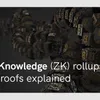ZKX wants to make using Google, Meta and Microsoft accounts with Web3 possible
Crypto.com-backed ZKX wants to build an accessible Web3 ecosystem for emerging markets. Its first product will be a decentralised derivatives exchange for institutional traders to enter Web3. Here’s how they plan to do it.
It’s tough to build accessible Web3 products. The current generation of these apps have clunky interfaces and complicated features. In a generation that is already mobile-first, apps in the Web3 space generally have a subpar mobile experience. This is partly why they’ve struggled to gain prominence, especially in emerging markets.
It begs the question: can there be a way to scale apps on the decentralised internet without risking user data?
Looking to solve this is - a startup founded in 2021 by Eduard Jubany Tur, Naman Sehgal, and Vitaly Yakovlev. ZKX is leveraging Zero Knowledge (ZK) to build an accessible and user-friendly ‘Layer 3’ ecosystem on top of Ethereum. More on ZK later.
For those who are new to the world of blockchains, Layer 3 protocols are an emerging breed of technologies to empower blockchain networks with the ability to conduct transactions across different blockchains.
They are a method through which interoperability between the internet as we know it today and Web3 can be achieved. This vision led ZKX towards raising $4.5 million from a clutch of investors, including StarkWare, Alameda Research, Amber Group, Huobi, Crypto.com.
Despite being cheaper than layer 1 protocols, the transaction fee or gas fee on layer 2 protocols are still pricey for users in emerging markets. “This is where layer 3 solutions come into play,” Eduard Jubany Tur, one of the co-founders, tells The Decrypting Story.
At the moment, ZKX is building its first product - a decentralised derivatives exchange for traders, which it claims has a waitlist of over two lakh users. After the exchange is rolled out, it will set out to build other products, such as developer tools to create an entire Layer 3 ecosystem.

What is ZK tech and Layer 3?
Blockchain transactions can be data heavy. This is what ZK tries to solve. Its most popular form, ZK rollups, bundle several of these data-heavy transactions together, allowing for validation of blocks in a cheap, fast and private manner.
In essence, this tech allows smart contracts to process and verify that bundled transactions are valid off the main blockchain like Ethereum. It does this without sharing or revealing any user data involved in the transaction and also allows developers to use the blockchain at scale.
ZKX is developing this tech on StarkWare - a platform that uses its native tech StarkNet ZK-rollup to allow decentralised apps to scale. Whatever transactions happen on StarkNet fall back on Ethereum.
Here’s how it works. If you conduct a transaction on Starknet, it will fall back on the main blockchain Ethereum. What ZKX is doing is build a protocol on top of Starknet, which is what makes it a layer-3 solution.
ZKX is hoping that by tapping into a structure like this, it will be able to build an entire ecosystem of its own – complete with its own infrastructure to compute transactions, all of which will be validated by its users – making the entire process decentralised.
It is important to note that the tech ZKX is betting on is yet to be proven on a larger scale. But there have been some promising efforts, like investments by the likes of Polygon to bring ZK-rollup tech front and centre.
But if it works, ZKX could potentially have an ecosystem where users can access and use Web3 apps using existing Meta (Facebook), Google or Microsoft accounts, without ever revealing or sharing user data with these third parties at scale.
Building a decentralised derivatives exchange
ZKX is looking to make Web3 products easy to access in emerging markets such as India and South East Asia. The exchange ZKX is setting up will allow traders to access Web3 in the same way they would without it. It will look to convert complex trade strategies into easy to trade crypto instruments like perpetual swaps.
The advantage it holds is making the exchange permissionless. With this, it can achieve greater decentralisation. To make things interesting for its users, ZKX will also have gamified leaderboards where the more stake you possess will reap you greater rewards. Users will also have greater say in what is listed on the exchange - also referred to as governance-enabled asset listing.
“India has robust trader communities, including those for derivatives," says Naman. According to him, the incoming wave of Web3 in developing nations like India is a testimony to emerging markets being ripe for disruptions, as they have similar economic and demographic patterns.
The founders believe this is an opportunity to give emerging markets accessible, Web3-based financial tools. Bringing more traditional traders onto Web3 is part of ZKX’s vision.

The Robinhood and Zerodha playbook
In order to ease users into trading via the exchange, the founders are looking towards companies like Robinhood and Zerodha, which currently have millions of users using their services on a daily basis.
“The Robinhood and Zerodha playbook is all about making difficult features and options easy to access and use through a simple mobile experience. This creates a new generation of traders. At ZKX, we have a chance to go mobile-first and build a global brand. Further, the simpler we make things for developers, the more adoption we will get. Polygon is a case in example," says Eduard.
The 30-member team is now focusing on several on-ground activations such as events and presence at Indian trader conferences to build momentum for its decentralised derivatives exchange. To be clear, Layer 3 technologies in blockchain are not entirely a brand new concept. Projects like Interledger Protocol, IBC Protocol, and Quant have all been looking to solve interoperability and scalability issues that have long plagued the blockchain sector.
In order to do this, projects are trying different experiments. For instance, dYdX - the largest decentralised project on StarkWare - recently left the platform in favour of building a standalone, Cosmos-based blockchain that claims to offer more decentralisation.
“20 years ago, explaining AWS or GoDaddy to somebody would be too difficult. Today, not everyone understands exactly how they work, but they are synonymous with the hosting infrastructure they provide. We expect the same thing will happen to Web3, ZK tech and Layer 3 solutions,” Naman says.
Edited by Akanksha Sarma









